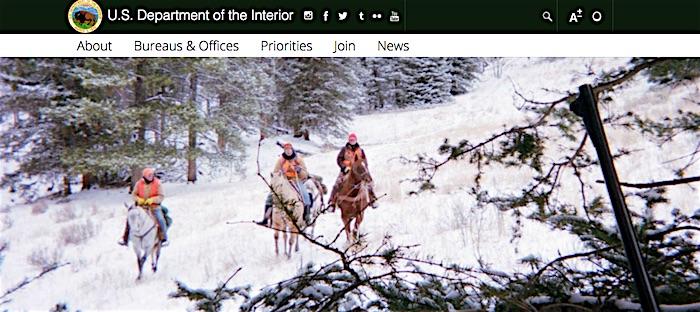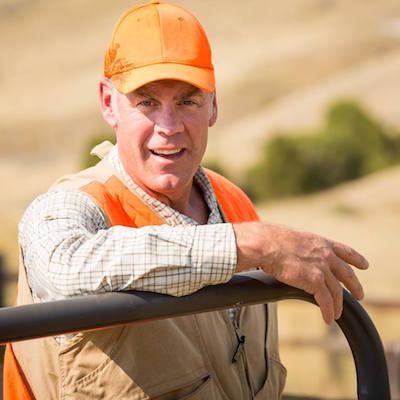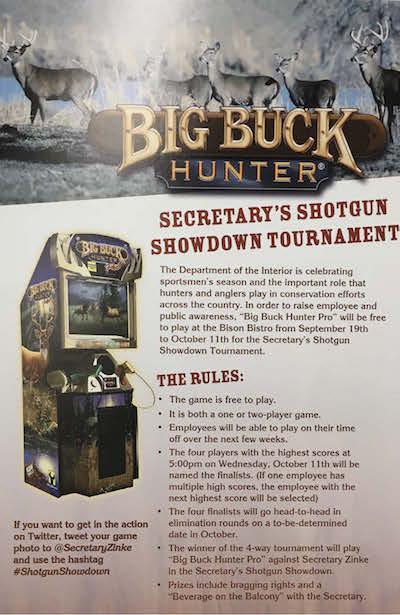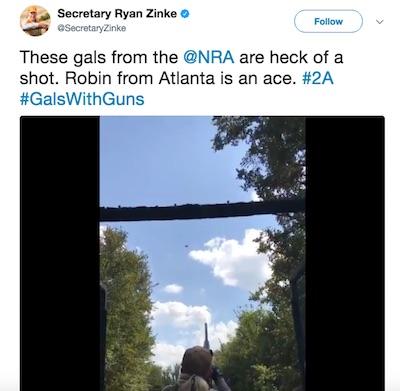
Lately, every month seems to be gun month at the Department of Interior/DOI
There's a new sheriff in town, and he's more than willing to have you test his aim.
Back in March, Interior Secretary Ryan Zinke rode into office on Tonto Silvershoes -- reportedly an Irish sport horse, not a Quarter Horse or American Paint -- in downtown Washington, D.C., and the only things missing were a rifle scabbard perched on his saddle and a six shooter dangling from his hip.

Interior Secretary Zinke is always ready to promote hunting on public lands/DOI
But Secretary Zinke quickly established his Western bona fides, not only with his horsemanship and ever-ready cowboy hat or orange hunting vest and ballcap, but also by reaching out (some might say overreaching) to the shooting community. Not only did he appoint Susan LaPierre, a National Rifle Association luminary and wife of NRA Executive Director Wayne LaPierre, to the National Park Foundation's Board of Directors, but he also has:
* Overturned the Obama administration ban on lead shot and fishing tackle.
* Told the National Park Service in Alaska to review its bans against the use of donuts and grease-soaked loaves of bread to lure bears into range of hunters.
* Proclaimed August as National Sports Shooting Month.
* Directed the land-management agencies under his auspices to, when possible, allow target shooting in national monuments, even though that's a significant cause of wildfires. (And then there was the target-shooting-related death at Tule Springs Fossil Beds National Monument in Nevada.)
* Declared October to be National Hunting and Fishing Month.
* Encouraged Interior employees to share their "hunting and fishing memories."
* Directed the U.S. Fish and Wildlife Service to open up, or expand, hunting and fishing on ten refuges.
* Had his staff issue a release on "Everything you need to know about hunting on public lands."
* And even installed at the Interior Department cafeteria in Washington, D.C., a "Big Buck Hunter Pro" arcade game so Interior employees could challenge their boss with their aim in a "Shotgun Showdown," with the "winner earning bragging rights and a personal visit with the Secretary."

Interior Secretary Zinke has added an arcade game to the Interior Department cafeteria
“Some of my best memories are hunting and fishing with my dad and granddad, and then later teaching my own kids to hunt and fish," Secretary Zinke said, rehashing a phrase he's used in quite a few of his previous proclamations. "That's something I want more families to experience. Hunters and anglers are the backbone of wildlife and habitat conservation in America because sportsmen contribute billions of dollars to conservation.
"From my perspective, the more sportsmen we have in the woods and waters, the better our wildlife and land will be. The 'Shotgun Showdown' will help reignite the passion and emphasis of hunting and fishing at the Department, and will be a fun way to advance our mission of wildlife and habitat conservation."
The "new" Interior Department's determined branding with the shooting and hunting industry also is evident on the photo depicting orange-clad hunters riding horses across a snowy landscape that graces the top of Interior's webpage (Did you spot the rifle?) and the secretary's occasional tweets regarding hunting and even the NRA.
On his Facebook page, the secretary also frequently calls out the hunting and fishing community and at times the NRA:
Today I joined the Women's Leadership Forum to shoot clays. Hunters and anglers contribute billions of dollars to conservation through excise taxes paid when sportsmen and women purchase firearms, ammo, and tackle. Millions more are raised through hunting and fishing licenses and Duck Stamps. The more target shooters, hunters, and anglers there are, the more funding for a conservation. Increasing access to public lands is key. -- September 23
Hunting and fishing is a big part of what we do at Interior from hunting on Bureau of Land Management land and U.S. Fish and Wildlife Service Refuges to fishing in National Park Service and Bureau of Reclamation waters. This week the Interior employee cafeteria got a new addition - the classic arcade game Big Buck Hunter. The game will be in the cafeteria, free to play, to get our employees excited about hunting season and to remind everyone about the important role that sportsmen and women play in conservation. -- September 18
September 23 is National Hunting and Fishing Day - held every year since 1972. It’s the perfect day for sportsmen and women to share their passion by mentoring future generations of hunters, anglers, and conservationists. -- September 18
Increasing access to public lands for hunting, fishing, and recreation is a top priority at the Department of the Interior. -- September 17
Hunting and fishing is a cornerstone of the American tradition and hunters and anglers of America are the backbone of land and wildlife conservation. The more people we can get outdoors, the better things will be for our public lands. As someone who grew up hunting and fishing on our public lands - packing bologna sandwiches and heading out at 4AM with my dad - I know how important it is to expand access to public lands for future generations. -- September 15
Great to see more Americans enjoying the great outdoors! This report is good news but also absolutely underscores the need to increase public access to public lands across the United States. Hunting and fishing are a part of the American heritage. As a kid who grew up hunting and fishing on public lands who later took my own kids out on the same land, I know how important it is to expand access for future generations. -- September 7
It's September which means more hunting seasons are opening up across the nation. Don't forget that public lands offer some of the best hunting opportunities -- September 1
On behalf of our nation's millions of hunters, I was proud to designate August as National Shooting Sports Month at the Department. I grew up in the mountains of northwest Montana, where I spent my time hunting and fishing on our shared public lands. I was lucky to take my boys out on the same land that my dad and granddad took me. -- August 31
Today I sent my report on the national monuments to the White House. No President should use the authority under the Antiquities Act to restrict public access, prevent hunting and fishing, burden private land, or eliminate traditional land uses, unless such action is needed to protect the object. -- August 24
This week the Department opened up access for hunting and fishing in 10 wildlife refuges across the country. I grew up in the mountains of northwest Montana, where I spent my time hunting and fishing on our shared public lands. I was lucky to take my boys out on the same land that my dad and granddad took me. -- August 11
I'm happy to announce today the Department intends to finalize the process to consider whether to accept 3,595 acres to make the Sabinoso Wilderness area accessible to hunters and all members of the public for the first time ever. Expanding access to hunting, fishing, and recreation on federal lands is one of my top priorities as Secretary. -- August 9

It goes on, but the trend is clear: Secretary Zinke is a BIG proponent of hunting and fishing.
And that's fine.
Both activities grew up with the country and play important roles, whether it's putting food on the table, helping manage species such as deer and elk in settings where there no longer are predators to control the populations, and instilling conservation ethics and a love for the outdoors.
How long before Secretary Zinke raises discussion of redesigning the logos for the Interior Department and the National Park Service to include rifle scope cross-hairs over the bison, and the NRA insignia on the mountain? And when it comes to controlling big game populations through hunting, perhaps that's a solution to the nonnative mountain goats at Olympic National Park, where a plan is in the works to reduce, and possibly eliminate, the population.
But, hunting and fishing aren't the only activities that benefit from public lands administered by the Interior Department, and the fact remains that hunting participation is on the slide while other outdoor activities are growing significantly and contributing much more economically. Indeed, participation and economic contribution from hunting are dwarfed by some other recreational activities on public lands.
According to the U.S. Fish and Wildlife Service's five-year report on outdoor recreation, released September 7:
Fishing
As one of the most popular outdoor recreational activities in the United States, fishing attracted 35.8 million individuals 16 years old and older in 2016. ... Anglers spent $46.1 billion on trips, equipment, licenses, and other items to support their fishing activities in 2016.
Hunting
In 2016, 11.5 million people, 5% of the U.S. population 16 years old and older, went hunting. ... Hunters spent $25.6 billion on trips, equipment, licenses, and other items to support their hunting activities in 2016.
Wildlife Watching
Wildlife watching is a favorite pastime for millions in the U.S. Over 86 million people 16 years old and older fed, photographed, and observed wildlife in 2016. ... They spent $75.9 billion on their activities
What the report did not touch on are the numbers of hikers and backpackers ($201.5 billion in annual spending), paddlers, skiers and snowshoers ($73 billion/year), campers ($166.8 billion/year), RVers, and rock climbers who enjoy public lands and also have a great economic impact. According to the Outdoor Industry Association, 42 million Americans hike, 45.8 million participate in biking (road, mountain and BMX), and 40.5 million camp (car, backyard, backpacking, RV). And, of course, 331 million folks went into the National Park System last year.
When will the secretary designate a "National Hiking Month" or a "National Birdwatching Day"?
At the end of the day, let's hope these other outdoor pursuits get equal time with the hunter-in-chief leading Interior.



Comments
Lest we forget, Theodore Roosevelt personally boasted of killing 50,000 animals, many of them on our public lands. My files bulge with his hunting stories from all across the West, including Grand Canyon and Yellowstone. "Mr. President, when will you set aside this infantile need to shoot and kill living things?" asked John Muir. TR never did.
If we want to rewrite the history, we should at least be honest about the times. When TR was president, well more than half of the population still lived on farms and in rural areas. EVERYONE hunted and fished. Now that we get our meat from a feedlot, who are we to judge? A century ago, if you didn't hunt--and grow your own fruits and vegetables--you couldn't just drive to the nearest minimart. If you didn't hunt something, you likely starved.
The hunting and fishing culture runs deep in America because we are barely a century past the midpoint between urban and rural life. A farmer, my grandfather hunted and fished. All of my uncles hunted and fished. Why get upset when a secretary of the interior happens to "promote" that lifestyle? At one time, all Americans promoted it, and indeed, bought everything that moved on four legs or flew on two wings in the farmers' markets of the country. What ended the decimation of wildlife? Hunters and fishermen, who insisted on seasonal, licensed hunting, rather than blasting away as Roosevelt did.
We owe hunters and fishermen a lot. But no, those bad boys carry guns! Let's face it. We are the romantics; we are the ones failing to appeciate that survival depends on killing. Oh, sure, Someone does it for us, and the results come to us in plastic wrap. It's all laid out for us there in the supermarket so we can play John Muir all day long.
I don't particularly like Zinke's emphasis on hunting, but then, our emphases are ahistorical, too. We forget that the public lands are the leftovers of the public domain, until 1935 open to occupancy, sale, and settlement. It should not surprise us that some Americans harbor strong feelings that are historically out of touch with ours. A historian, Theodore Roosevelt knew how to live in both camps, which is why he was able to accomplish so much. A conservationist, he still believed in the homesteader and the right to use the public lands.
If anything, we can blame Mr. Zinke for being overzealous, now to forget that homesteaders are a thing of the past. With feedlots, we don't need the public lands for meat. We just cannot expect millions of Americans to forget the past so soon. They may seem infantile, as they did to Muir, but then, he was a millionaire, too.
Perhaps Zinke is taking aim at his next job: Executive Director of the NRA when Wayne LaPierre retires. Would be a significant increase in salary and perks.
Very well said, Alfred Runte! The Hunter Gatherer roots run deep and as much as they may be glossed over by technolgy and the resulting detachment from the food chain taking it for granted many try and maintain the connections that fill a void. Not for sissies:).
To Kurt and Rebecca. First I must say I am very much surprised by your economic take on this as I was under the impression you were always against letting money influence decisions or policy. That said, I will point out that if you look at "per person" spending, sportsman far outspend the other groups. I'd also ask how his reaching out to these groups in any way harms the others? I would also argue that not only have hunters been neglected in the past but under attack by people with the mindset of Rebecca, so I see this reaching out as a positive step. If I really wanted to play devils advocate a case could be made that we could reduce the number of hikers and photographers and replace them with half the number of hunters and get the same economic benefit while also reducing crowding in the parks at the same time. Which is why as a hiker, camper and rather poor photographer, I will be the last one to criticize hunters or those who welcome them. I don't in any way feel I am being neglected or that my pastimes are in jeopardy by these actions. (Also, thanks for the linked reports Kurt. The geek in me finds these very interesting).
I don't believe anyone posting here has made any attempt, nor had any inclination to somehow disparage hunters in any way. But what we are trying to say is simply that there are some places where hunting is simply not appropriate.
Let's also note that there may be a very big difference between responsible hunters and irresponsible gun owners who use petroglyphs, road signs and outhouses as targets or who cut loose with barrages of bullets without considering where those bullets may be going.
National parks and monuments are not appropriate places for shoot 'em up bang bang.
Wild, since you bring up economics, I'll ask first whether you've donated to the Traveler? The Traveler exists to keep folks such as yourself informed and up-to-date with what goes on in the National Park System, and we can only do that if the readership -- which runs upwards of 1.6 million a year -- supports us. Without support, we'll be forced to turn the lights off. And since you don't use your real name, I don't know if you've contributed yet. So, have you?
Now, to the heart of your question: The point of the article was that the secretary shouldn't focus solely on one public lands constituency; there are many that care for and support the public landscape. The economic data was cited not to "let money influence decisions," but rather to point out that there are others besides the hunting and fishing community who contribution billions to the economy. It's not as one-sided as the secretary would make it appear.
And in an effort to presage your response, I've said it several times already, we're not against hunting or fishing here at the Traveler. We're certainly not criticizing them, as you imply. Those activities have long traditions and need to remain on the landscape. That said, we would hope that the secretary soon will recognize the values, and traditions, of the other outdoor communities.
As to the devil behind you, hunters (when they're hunting) don't contribute to crowding in the national parks, and you can't use them to replace hikers and photographers. More so, your math won't pencil out. Hikers and backpackers alone contribute $201.5 billion annually, whereas hunters spent $25.6 billion, and just a fraction of that in the few places in the National Park System where hunting is allowed.
The fact is that there are plenty of public lands already open to hunting and shooting. The national parks were not set up for those purposes, and need not be used for those purposes. As to TR: He once wrote that Yellowstone greatest use could be to "open it up to men of science." THAT is the value of preservation, so nature without much impact from modern man can be studied, as a reservoir of research and knowledge. Zinke is our current Pinchot, not our current TR.
But Pinchot was an honorable man who sincerely believed he was doing the right thing. Many of his ideas turned out to be correct. Pinchot was seeking to establish careful and responsible management of public forest lands. He was NOT defending the robber barons of the time who had nearly succeeded in complete destruction of many of our natural resources.
Our current administration is working to reverse the work of Gifford and Teddy.